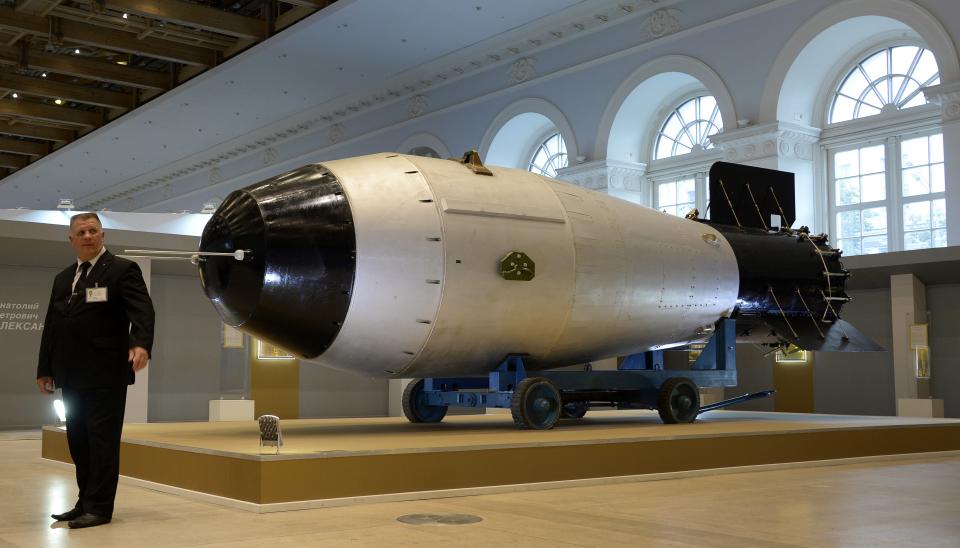The terrifying story of the most powerful nuclear bomb ever detonated, which broke windows 560 miles away

In October 1961, plane crews took off from an airfield in northwestern Russia on a mission where they were given a 50% chance of survival.
They boarded aircraft painted white to reflect the flash from a nuclear blast.
Crew members carried protective glasses to prevent them going blind.
One plane had been specially modified to carry a huge bomb, the most powerful ever designed (although leaks this year have revealed Russia is working on a new torpedo with similar destructive power).
The bomb – known variously as the ‘Tsar Bomba’, or more fondly as ‘Big Ivan’ – was a 50 megaton hydrogen bomb, weighing 27 metric tons.

The 26-foot long device was attached to a parachute which itself weighed a ton, to give the aircrews time to fly away from the blast.
Even so, the plane which dropped ‘the Tsar’ fell a kilometre when the shockwave hit it, as the bomb created a fireball five miles wide.
The flash was visible six hundred miles away.
The explosion is thought to have been 1,500 times as powerful as the Hiroshima and Nagasaki bombs put together, and ten times as powerful as all the bombs detonated in World War 2.
One observer described seeing a white flash, and then a rumble ‘as if the Earth had been killed.’
The device had actually been modified to reduce its yield in an effort to prevent nuclear fallout, and only exploded with about half its real power.
One witness said, ‘The clouds beneath the aircraft and in the distance were lit up by the powerful flash.
‘The sea of light spread under the hatch and even clouds began to glow and became transparent. A huge bright orange ball was emerging. Having broken through the thick layer of clouds it kept growing. It seemed to suck the whole earth into it.’
Shockwaves meant that windows were broken nearly six hundred miles away – as far as Berlin is from London.
At 35 miles from the blast, all buildings in the small town of Severny were flattened and completely destroyed.
A mushroom cloud 40 miles high towered over the detonation site, where the bomb had exploded 13,000 feet above the ground.
Even so, the ground beneath was described as being scoured clean even of rocks, and resembling an ice rink.
A team member said, ‘“The ground surface of the island has been levelled, swept and licked so that it looks like a skating rink. The same goes for rocks.’
But the bomb marked a turning point – it was so large it effectively couldn’t be used, and catalysed talks which led to the first arms limitation treaties.
Its creator, nuclear physicist Andrei Sakharov became a vocal opponent of nuclear weapons.
MOST POPULAR ON YAHOO UK TODAY
Teenager, 18, who repeatedly raped woman at gunpoint in ‘twisted tag team’ jailed for 20 years
Don’t Tell The Bride couple DON’T get married for first time in show’s history
Bentley driver caught breaking 20mph tells speeding volunteers he’ll report THEM to police
‘Manipulative’ benefits fraudster, 51, claimed up to £500k by pretending to be quadriplegic
Theresa May has been given a surprisingly adorable nickname during her visit to China
Mystery of Jack the Ripper letters may finally have been solved as ‘similarities’ are found
Sakharov published anti-nuclear tracts in Russia, which circulated illegally, and were then published in the West.
He eventually received the Nobel Peace Prize for his efforts in attempting to persuade the superpowers to pull back from nuclear war.
Sakharov wrote, ‘Every rational creature, finding itself on the brink of a disaster, first tries to get away from the brink and only then does it think about the satisfaction of its other needs. If mankind is to get away from the brink, it must overcome its divisions.
He wrote his own chilling description of the effects of thermonuclear war: ‘A complete destruction of cities, industry, transport, and systems of education, a poisoning of fields, water, and air by radioactivity, a physical destruction of the larger part of mankind, poverty, barbarism, a return to savagery, and a genetic degeneracy of the survivors under the impact of radiation, a destruction of the material and information basis of civilization – this is a measure of the peril that threatens the world as a result of the estrangement of the world’s two super-powers.’

 Yahoo News
Yahoo News 

